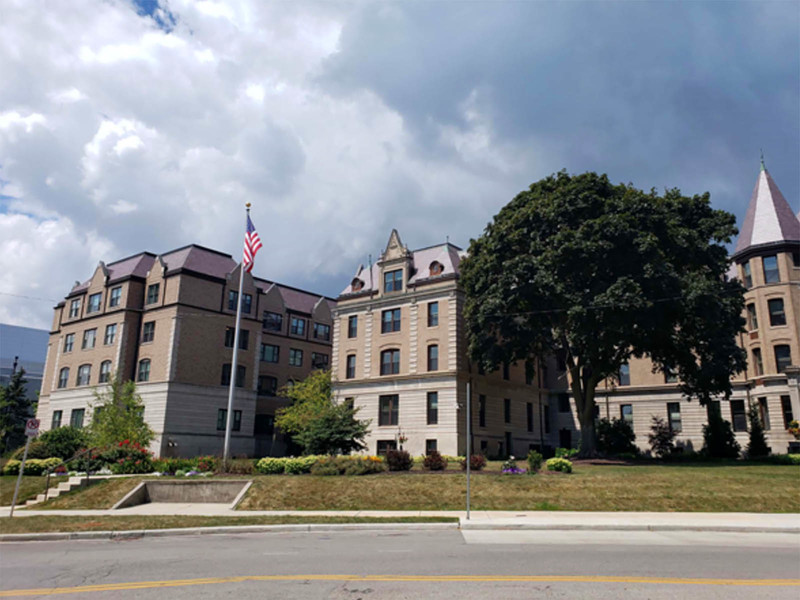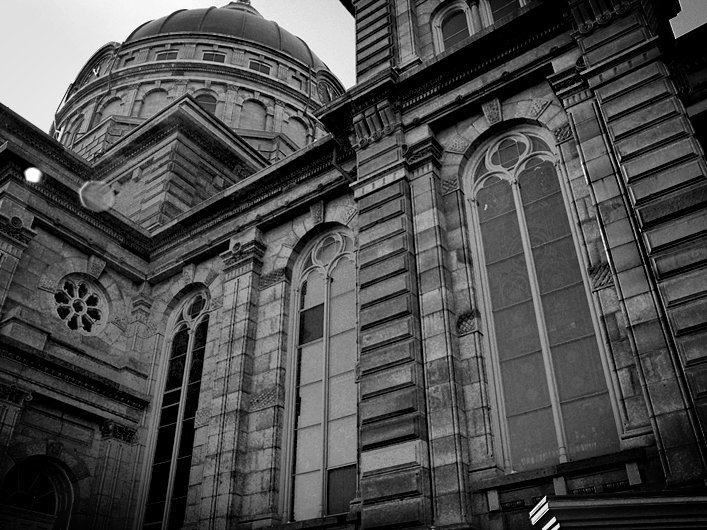 It may not be Paris or Rome or London, but Milwaukee has some wonderful buildings and there are some in particular that should not be missed. Here are just a few of the more important ones, in no special order.
It may not be Paris or Rome or London, but Milwaukee has some wonderful buildings and there are some in particular that should not be missed. Here are just a few of the more important ones, in no special order.
The fortress-like F.C. Bogk House at 2420 N. Terrace Ave. is the only single-family residence in Milwaukee built by Frank Lloyd Wright. Executed at the time when Wright spent much of his energy on Tokyo's Imperial Hotel, the house was nonetheless built under the architect's watchful eye. Unlike many of his structures, which appear almost weightless, the Bogk House is a solid-looking brick structure trimmed with cast concrete that appears impregnable. A private residence, this house is only very rarely opened to the public, and the interior is reputed to be in as immaculate a condition as the exterior. Completed in 1916.
Santiago Calatrava's soaring addition to the Milwaukee Art Museum is already Milwaukee's lakefront jewel with its graceful lines, sailboat white tone, and astonishing organic form. The architect's first structure in the U.S. a daring work that is stunning when approached from any direction and the mast supporting the footbridge beckons all heading east on Wisconsin Ave. to come and behold its magnificence. By the way, he planned it that way, even altering plans by a few feet to ensure that the mast would align perfectly with the center of Wisconsin Avenue.
 Anyone familiar with 1970s television needs
no introduction to Milwaukee's soaring city hall, which featured prominently in
the opening of "Laverne & Shirley." Built in the 1890s, the H.C. Koch &
Company-designed building has become one of Milwaukee's most recognizable landmarks.
Similar to Renaissance revival buildings constructed in northern Europe in the
latter part of the 19th century, the city hall topped a black granite
base with a wide layer of sandstone and capped it off with brick structure garnished
with terra cotta ornamentation. The clock tower rises 393 feet and houses a 10-ton
bell that was once among the world's largest. Alas, ringing such a large bell
has detrimental effects on the aging structure and is therefore mostly silent.
The building's interior, with a colossal atrium, is no disappointment, either.
Anyone familiar with 1970s television needs
no introduction to Milwaukee's soaring city hall, which featured prominently in
the opening of "Laverne & Shirley." Built in the 1890s, the H.C. Koch &
Company-designed building has become one of Milwaukee's most recognizable landmarks.
Similar to Renaissance revival buildings constructed in northern Europe in the
latter part of the 19th century, the city hall topped a black granite
base with a wide layer of sandstone and capped it off with brick structure garnished
with terra cotta ornamentation. The clock tower rises 393 feet and houses a 10-ton
bell that was once among the world's largest. Alas, ringing such a large bell
has detrimental effects on the aging structure and is therefore mostly silent.
The building's interior, with a colossal atrium, is no disappointment, either.
St. Paul's Episcopal Church at 914 E. Knapp St., houses the city's oldest Episcopal parish (founded in 1838) and was designed by hometown boy Edward Townsend Mix, who was responsible for a number of well-known buildings in Milwaukee. The Romanesque church, constructed of rustic Lake Superior sandstone has huge arches and battlemented parapets that lend the church an almost castle-like quality. New York's Tiffany Studios contributed many of the stained-glass windows. According to one source, the building closely resembles an unbuilt church designed by Henry Hobson Richardson, the plans for which had been published in the Architectural Sketch Book in the 1870s. Completed in 1884.
 The Prairie Style house at 2430 E. Newberry
Blvd. on the East Side was designed by Wright apostle Russell Barr Williamson.
A Milwaukee native, Williamson designed a number of Prairie Style residences in
the city that closely adhered to Wright's style. This house, for example, has
the same strong horizontals and leaded glass windows with gold-mirror squares
that mark Wright's work. Notice the horizontal band of windows beneath the wide
eaves and (in summer) the sympathetic landscaping. Completed in 1921. Williamson
also designed the recently-shuttered Avalon Theatre in Bay View.
The Prairie Style house at 2430 E. Newberry
Blvd. on the East Side was designed by Wright apostle Russell Barr Williamson.
A Milwaukee native, Williamson designed a number of Prairie Style residences in
the city that closely adhered to Wright's style. This house, for example, has
the same strong horizontals and leaded glass windows with gold-mirror squares
that mark Wright's work. Notice the horizontal band of windows beneath the wide
eaves and (in summer) the sympathetic landscaping. Completed in 1921. Williamson
also designed the recently-shuttered Avalon Theatre in Bay View.
Frank Lloyd Wright was extremely interested in low-cost housing and experimented with pre-fab structures. Four experiments in his American System Built Homes line the north side of West Burnham Street (2714-2732). These duplexes are of nearly identical floor plans (one is reversed). However, Wright was not involved in the construction of these homes and the materials used were not top quality. A pair of four-unit apartment buildings built in a different System Built plan on North 27th Street have been demolished. Some System Built bungalows remain in the Milwaukee area.
The last remaining Federal style commercial building in Milwaukee is also the oldest brewery building in the city. The Gipfel Union Brewery has been threatened with demolition for many years and that war has intensified due to pressures exerted by crowds generated by southern neighbor the Bradley Center. Built in 1853, the Gipfel Union Brewery, 423 W. Juneau Ave., functioned as a brewery until 1890.
Eero Saarinen's War Memorial building, which gazes out over the lake from its perch at the foot of East Mason Street, was one of the city's most unusual buildings when it was completed in 1957 as a paean to the fallen veterans of World War II and the Korean War. A large, abstract mosaic by native artist Edmund D. Lewandowski welcomes visits from the west, as does a tempting glimpse of the lake thanks to Saarinen's elevated design. Though the cross-shaped building has some practicality issues, as anyone who has spent any time inside can readily confirm, the building offers great views from all sides and has a captivating exterior. Alas, a 1970s addition to make more room for the Milwaukee Art Museum, housed here, is a boxy eyesore.
It appears that aliens have landed at North 92nd Street and Congress Avenue on Milwaukee's northwest side, but don't panic, it's simply Frank Lloyd Wright's Annunciation Greek Orthodox Church building. When the congregation outgrew its downtown building in the early 1950s, its forward-looking community approached Frank Lloyd Wright, who came up with this design based on his investigations into Greek Orthodox traditions. Wright took two elements of that tradition -- the dome and the Greek cross -- and merged them in this unusual building with lovely stained glass windows (not by Wright, but rather by a New Berlin-based studio) and a circular balcony. Wright died two months before construction began and when the church was completed in 1961, it came in at three times the estimated cost. Tours are available. Call (414) 461-9400.
Other notables:
U.S. Bank Center, 777 E. Wisconsin Ave., Skidmore, Owings, & Merrill, 1973.
MGIC Plaza, 250 E. Kilbourn Ave., Skidmore, Owings , & Merrill with Fitzhugh Scott Architects, 1971-'72.
Bank One Plaza, 111 E. Wisconsin Ave., Harrison & Abramovitz, 1960-'61, the first glass skyscraper in Milwaukee.
Mitchell & Chamber of Commerce buildings, Edward Townsend Mix, 1876 & 1879-'80, the Grain Exchange Room in the latter is exquisite.
Northwestern Mutual Life Insurance Building, S.S. Beman, 1885, has one of the best-preserved 19th century commercial interiors with ornamental iron, lovely tile floors, and marble wainscoting.
Born in Brooklyn, N.Y., where he lived until he was 17, Bobby received his BA-Mass Communications from UWM in 1989 and has lived in Walker's Point, Bay View, Enderis Park, South Milwaukee and on the East Side.
He has published three non-fiction books in Italy – including one about an event in Milwaukee history, which was published in the U.S. in autumn 2010. Four more books, all about Milwaukee, have been published by The History Press.
With his most recent band, The Yell Leaders, Bobby released four LPs and had a songs featured in episodes of TV's "Party of Five" and "Dawson's Creek," and films in Japan, South America and the U.S. The Yell Leaders were named the best unsigned band in their region by VH-1 as part of its Rock Across America 1998 Tour. Most recently, the band contributed tracks to a UK vinyl/CD tribute to the Redskins and collaborated on a track with Italian novelist Enrico Remmert.
He's produced three installments of the "OMCD" series of local music compilations for OnMilwaukee.com and in 2007 produced a CD of Italian music and poetry.
In 2005, he was awarded the City of Asti's (Italy) Journalism Prize for his work focusing on that area. He has also won awards from the Milwaukee Press Club.
He has be heard on 88Nine Radio Milwaukee talking about his "Urban Spelunking" series of stories, in that station's most popular podcast.







